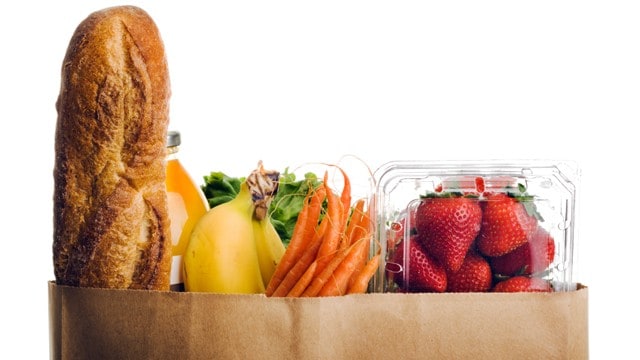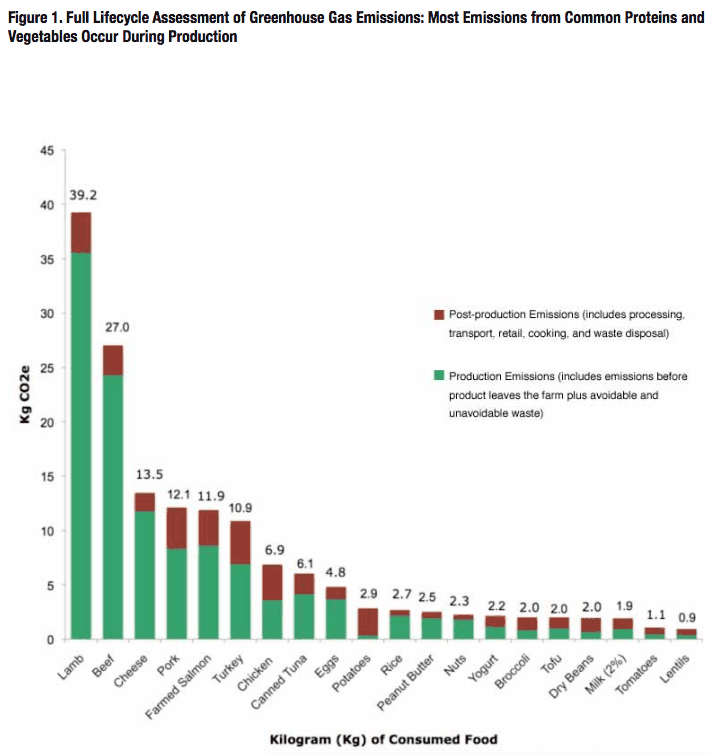
In 2010, the United Nations released a report urging the public to adopt a predominantly plant-based diet for a number of reasons. Besides the obvious health benefits of consuming more wholesome, unprocessed fruits, vegetables, nuts, seeds, and leafy greens, the report noted the environmental effects caused by consuming large amounts of animal products.
Shortly after, a report called the “Meat Eater’s Guide to Climate Change + Health” was released by The Environmental Working Group and CleanMetrics Corporation identifying the same need for civilians to become more mindful of their eating habits.
As you can see below, and as Business Insider shares, not all foods are created equal when it comes to their carbon footprint.

The graphic from the report (above) shows each food broken down by greenhouse gas emissions. (For example, the average car today emits about 0.41 kilograms of Co2 per mile driven.)
With climate change confirmed to be a very real concern, knowing which foods have the highest CO2 output can help you shop as an informed consumer and contribute to a greener Earth.
-
Lamb: 39.2 kg CO2
Consuming one kilo of lamb is equivalent to driving about 90 miles! According to the EWG/CleanMetrics report, an astonishing 50% of lamb in the US is imported, so some of its carbon footprint comes from shipping. But most of it is produced by the animals’ digestion (aka lamb farts), their feed, manure management and other farm operations.
-
Beef: 27 kg CO2
This product may not be as bad as lamb, but beef still has one of the highest carbon footprints. Cows produce a lot of methane (a potent greenhouse gas), and also require a lot of water and land, as this Business Insider analysis found.
-
Cheese: 13.5 kg CO2
Animal products of any kind tend to be the worst for the environment. Only a small fraction of cheese is imported, but that accounts for half of all the carbon emissions from cheese, says the report.
Pork: 12.1 kg CO2
It’s not kosher, and it’s not good for the environment. More than half of the emissions from pork come from raising the animals, but a large amount comes from processing, transporting, and cooking the flesh at home.
-
Farmed Salmon: 11.9 kg CO2
The report shares that the biggest source of greenhouse gas emissions from farmed salmon is feed production, electricity generation, and on-farm fuel combustion. The data did not include the emissions from wild caught salmon.
-
Turkey: 10.9 kg CO2
Thanksgiving is the farthest thing from a green holiday, as millions of Americans serve up roast Turkey in celebration each fall. Most of the greenhouse gasses from turkey come from feed production (especially corn), followed by processing and home cooking.
-
Chicken: 6.9 kg CO2
If you’re a meat-eater seeking to lessen your carbon footprint, it seems chicken is the animal to opt for. Chickens produce the least amount of greenhouse gas emissions of most popular types of meat. The report shares that the main sources of CO2 are the same for turkey, but chicken produces less overall emissions during each phase of production, processing, and cooking.
-
Canned Tuna: 6.1 kg CO2
This food has become a staple in many American households. Not only is tuna high in Mercury, the production of the fish (caught in the ocean and canned) produces most of its greenhouse gas emissions (68%) during diesel combustion on fishing boats. The rest mainly comes from processing and packaging tuna, as well as transporting it.
-
Eggs: 4.8 kg CO2
Eggs are a staple to rely on if you’re aspiring to “go green” but not fully plant-based. The figure above is based on the average of a Canadian large-scale free-range farming operation and a New Jersey large-scale confined operation. Most of the emissions come from feed production, on-farm energy use, nitrous oxide gas from the poultry litter and fuel combustion.
-
Potatoes: 2.9 kg CO2
The only non-animal food on this list, potatoes produce the most emissions of all protein-rich plants. Most of the footprint comes from cooking, but it varies depending on how they’re cooked and for what length of time. For example, a baked potato produces much more emissions than French Fries, as the snack takes much less time to cook.
“Of course, there are many other factors at play in deciding which foods you should eat, such as nutrition, ethical farming/production practices, and, of course, personal preference,” notes Business Insider.
What are your thoughts? Comment below and share this news!
This article (These 10 Foods Have The Biggest Environmental Footprint) is free and open source. You have permission to republish this article under a Creative Commons license with attribution to the author and TrueActivist.com


